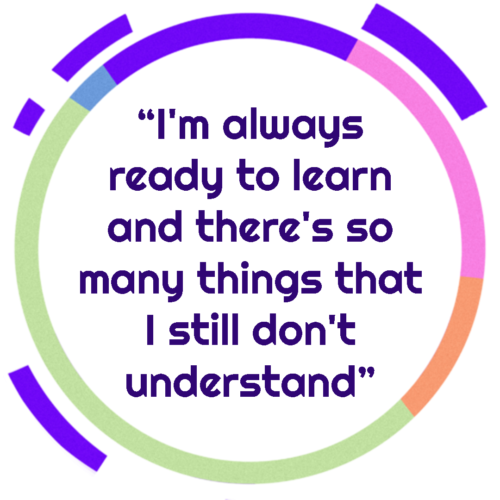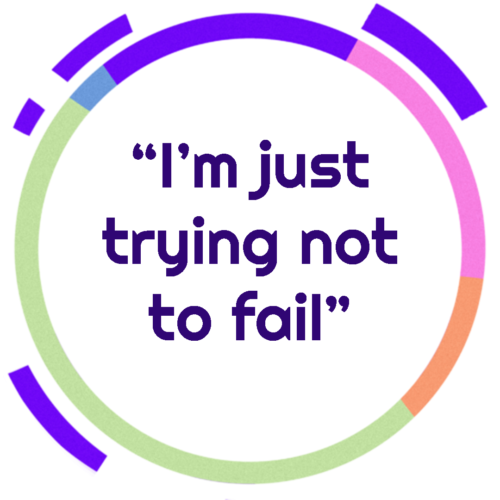The road to financial wellbeing is a long and hard one for many first-generation Ryerson students
Words by Nishat Chowdhury
Visuals by Laila Amer
On a crisp Wednesday in October 2019, Ana Leal typed away on her computer as she anxiously watched the time on her phone. A first-year journalism student at the time, Leal rushed to submit her news story by the 6 p.m. deadline. While her peers around her made plans to go out for sushi after and take naps once they got home, Leal ran to catch the subway to make it on time for her evening shift at Two Peas Pod hostel in Chinatown at College and Spadina streets.
She got home from her shift around 11:30 p.m. exhausted from the day, trudging into the shower where she began to cry. The shower was the only moment where Leal could let her feelings show. “I don’t have the time to have meltdowns otherwise,” says the former second-year journalism student, who was forced to take the 2021-22 academic year off due to cuts to her Ontario Student Assistance Program (OSAP) funding.
Leal was previously a sociology major at McMaster University, but dropped out after her second year because she wasn’t happy there. When she transferred to Ryerson in the 2019-20 school year, she was told by OSAP she wouldn’t be given any more student loans until she paid off what she owed from her time at McMaster. When she learned this, Leal was already in Toronto, enrolled in a full course load at Ryerson with the impression she’d be getting funding. As payments kept getting delayed and then denied, Leal had to front the bill for her first year at Ryerson on her own.
She was working 35 hours a week with two part-time jobs on top of balancing a full course load; one being a front-desk assistant at her program’s office. Still barely making ends meet, it was the only way she could afford her studies while living in Toronto. She frequently fell ill because she was sleeping less than five hours a day and skipping meals due to a lack of free time. “You make the best of what you’re given. I didn’t really have a choice,” says Leal.

At Ryerson, many first-generation students report coming from families that didn’t adequately plan financially for their children’s education, leaving them to fend for themselves. Without registered education savings plans (RESP) or any financial support, these students are grappling with full-time studies often with multiple part-time jobs to pay for their educational and everyday expenses. The lack of conversation and education about financial literacy means many first-generation students at Ryerson are alone in learning how to set themselves up for financial success.
Joan Lobo, a former manager at BMO and a contract lecturer at the Chang School of Continuing Education at Ryerson University, says it’s harder for first-generation students to save because their line of sight is focused on today’s financial obligations—such as putting food on the table and paying tuition, rent and other day-to-day expenses. “This leaves them with little or no excess funds to invest or save for retirement.”
Lower-income parents are also less likely to open an RESP for their children, according to a July 2020 study by Statistics Canada. The study says the low participation rates are due to a lack of wealth and poorer financial literacy. Families in the lower-income bracket, who make around $30,000, were less likely to open an RESP compared to families in the highest income bracket who made more than $80,000 per year. Many first-generation Canadian families are in that low-income bracket. According to a December 2019 study from the Canadian Centre for Policy Alternatives that evaluated employment income, racialized first-generation immigrant men earned 71 cents for every dollar that non-racialized immigrant men earned. Racialized first-generation women earned 79 cents for every dollar that non-racialized immigrant women earned. This leaves a larger toll on first-generation students to support themselves and set themselves up for a better future.
However, as they get older, many first-generation students are learning to better manage their finances and broaden their financial literacy, but it’s a process they say often feels daunting. Saving money and budgeting sometimes seems impossible, and the pressure of meeting expectations and supporting their families leaves first-generation students like Leal stressed. Yet, she’s still open to growing. “I’m definitely maturing financially, but I’m always ready to learn and there’s so many things that I still don’t understand.”

t the tail end of summer 2019, Hripsime Karapetyan came home from a relaxing weekend at her friend’s cottage when she received an email from the university congratulating her for winning The Jon and Nancy Love Entrance Award. Given to one student entering their first-year at the Ted Rogers School of Management (TRSM), the renewable entrance scholarship covers up to 90 per cent of the costs of tuition. She started screaming and running around the house when she discovered she’d won. “That was one of the best moments of my life,” says the now third-year global management student. Without it, Karapetyan wouldn’t have been able to afford to attend Ryerson.
Karapetyan’s family immigrated to Toronto from Armenia in 2009 when she was just seven years old. While her parents came with some savings, their money was allocated towards necessities, including rent for a small one bedroom apartment where the family lived, other living expenses and her braces, which racked up to be thousands of dollars. To try and save up for tuition herself, Karapetyan worked many part-time minimum wage jobs as a teenager including babysitting, working at retail stores like Call It Spring and Garage, and being a cashier at FreshCo during the height of the pandemic. But as a teenager with some extra pocket money, she wasn’t the best at saving and ended up using her money to go out with friends and to purchase clothes and a new phone—things she couldn’t freely buy growing up.
Functioning paycheck to paycheck, Karapetyan says working from a young age caused hyperfixation on her personal finances. “I’ll shop and constantly think back: ‘If I didn’t have that, this would be in my savings right now,’” says Karapetyan, who says she is working on being kinder to herself instead of regretting all her mistakes and decisions around money.

The third-year global management student says the mandatory finance courses she took at TRSM helped her educate herself with money, including learning about accounting and taxes. Prior to that, the largest piece of financial advice Karapetyan got from her parents was when they told her “don’t spend too much and save as much as you can”
Lessons on financial literacy were nonexistent in high school. Concepts like investments and budgeting were unfamiliar to her until she started taking the mandatory finance courses as part of her degree. In Ontario, there was no financial literacy course for secondary school students until recently. In June 2021, Stephen Lecce, the province’s minister of education, announced a new Grade 9 math curriculum that includes more real-life examples of mathematical concepts, such as financial literacy and coding. According to Lecce in a video announcement, skills such as understanding the appreciation and depreciation of assets and learning how to modify a budget based on changes in circumstances will be taught.
According to Lobo, this new curriculum is long overdue. “Nobody should be graduating without participating in a financial literacy course that teaches them how to manage their finances,” she says. Lobo adds that it’s important to instill in students that they will be dealing with money every day in one way, shape or form for the rest of their lives. “This foundation that they’re learning in high school will help them get to that better position.”
While she’s glad it exists now, Karapetyan thinks it would’ve been helpful if this curriculum existed when she was in high school. Maybe then it wouldn’t feel like she’s starting from scratch at a much older age. In Grade 12, a confused Karapetyan would watch and listen as her peers got their RESPs ready and set up for tuition payments for their first year of university, while she had no idea what an RESP even was. Instead, she was applying to OSAP and as many scholarships and bursaries as she could.
An RESP is a special savings account sponsored by the Canadian government which allows parents to invest in their child’s post-secondary education. Contributions to the account are tax-free earnings, and the government pitches in some funds for children aged 18 and under, according to Investopedia.

Karapetyan says in order to make financial literacy lessons relevant to students’ lifestyles and circumstances, it’s important to keep the language simple and put an emphasis on why being financially responsible will help them in life. She suggests structuring budgeting lessons to show kids how to save up for things they want and approaching financial education without intimidation.
Karapetyan says teachers also have the responsibility to remind students that it’s OK if they don’t have any prior financial knowledge, and they’re in the class to learn—there’s no such thing as stupid questions. “It can be hard to learn about finances when your relationship with money is so difficult and complicated,” says Karapetyan.
At this point in her life, Karapetyan says paying off her student loan debt and saving up for law school are her biggest challenges. She sometimes loses sleep thinking about how daunting it feels to know she has to pay every cent of law school herself, which costs an average of $17,000 a year in tuition alone across Canadian law programs, according to CBA National Magazine, the official periodical of the Canadian Bar Association. While the people she grew up with had financial support from their families, Karapetyan says first-generation students are new players to the game with no foundation.
“Most people have their feet firmly in the ground already, they’ve been here for generations. They’ve set up the roots and their foundations,” she says, whereas she doesn’t have any roots or foundation yet to set her up for financial stability. “I’m just trying not to fail.”
And while younger Gen-Z students are already more stressed out than generations before, having the onus to teach yourself finances becomes an added weight. In the 2016 Canadian National College Health Assessment, 58 per cent of Gen Z adults in post-secondary school reported that their academics were a significant source of stress within the last 12 months. For first-generation students who are born into precarious financial situations, it is an added challenge of being a student, according to Dr. Mel Borins, a family physician and associate professor in the department of family and community medicine at the University of Toronto.
In today’s remote learning era, the insecurity of having enough money to pay bills, food and living accommodations, as well as supporting family adds to the total stressors. “There’s no question that’s stressful,” he says.
Now, Karapetyan tries to budget. Instead of spending money at restaurants, bars and shopping trips at the mall when hanging out with friends, she opts for long walks, biking or rollerblading around the city to catch up with loved ones. Committed to saving money and getting physical exercise, last summer, Karapetyan and her best friend both learned how to rollerblade and bike together.
The two girls spent their past two summers zooming along the lakeshore on their bikes and rollerblades, which they purchased secondhand. Or they’d go on hours-long walks at High Park, where they would stop to climb trees and feed the chipmunks and birds. “You don’t have to go out to a restaurant to hang out, you know? Not every time at least,” says Karapetyan.

rowing up in London, Ont., Leal’s family didn’t have money to save or invest; it wasn’t taught to her or her siblings by their Colombian parents, nor was it a topic of conversation in school. While she says her parents have learned a thing or two about finances over the years, they weren’t in a place to explain those things to Leal when she was first moving out of the house.
Now, Leal is on a personal journey to become more financially literate and better handle her money. While her credit score has gone up in the last year and the sum of money in her savings has grown, her 2022 New Year’s resolution is to learn more about investing. To start, she bought a financial help book called You Are A Badass At Making Money: Master The Mindset of Wealth by Jen Sincero. She’s also thinking about meeting with a financial advisor at her bank to sit and talk about getting a better foundation on how investing works at the most basic level.

But she still feels out of place for wanting to learn more. “It definitely feels like something that doesn’t belong to me or is not a place for me,” she says. “But I am trying to put my big girl pants on and be like, ‘I got this.’” says Leal, who tends to put responsibility on herself to financially take care of her family when hard times hit.
On her quest to become more financially literate, Leal has looked to the people around her who are good with money or are financially stable for advice, like her best friend who she feels comfortable talking to about money. On the other hand, female content creators such as @TheFinancialDiet and @herfirst100k on Instagram have majorly helped Leal learn methods to save money and budget. “It’s empowering to see young women talking about money, talking about savings and investing. That makes it a little bit more welcoming for me.”
While the road ahead is hard and there’s lots left to learn, by taking finance courses and actively trying to develop better habits, first-generation students are on the right path. With a better looking bank account and high hopes for her future, Leal hopes to return to Ryerson in the next year or two to pick up exactly where she left off.
“I was really happy when I was in school and I had such a good experience. And that’s the reason I want to go back and finish my schooling,” says Leal.










Mike Bratton
Excellent article. Equity, diversity, and inclusion seems to be a common pursuit in most post secondary institutions these days. But poverty, as a category of disadvantage, is excluded in the so-called inclusion. This is not fair or equitable. I am all in favour of EDI — it is necessary. But these EDI initiatives — if they are honest, fair-minded, and evidence informed — absolutely have to stop ignoring the impact of social class on equitable access to educational opportunity. This is in no way a critique of EDI, it is a critique of what is missing from EDI.